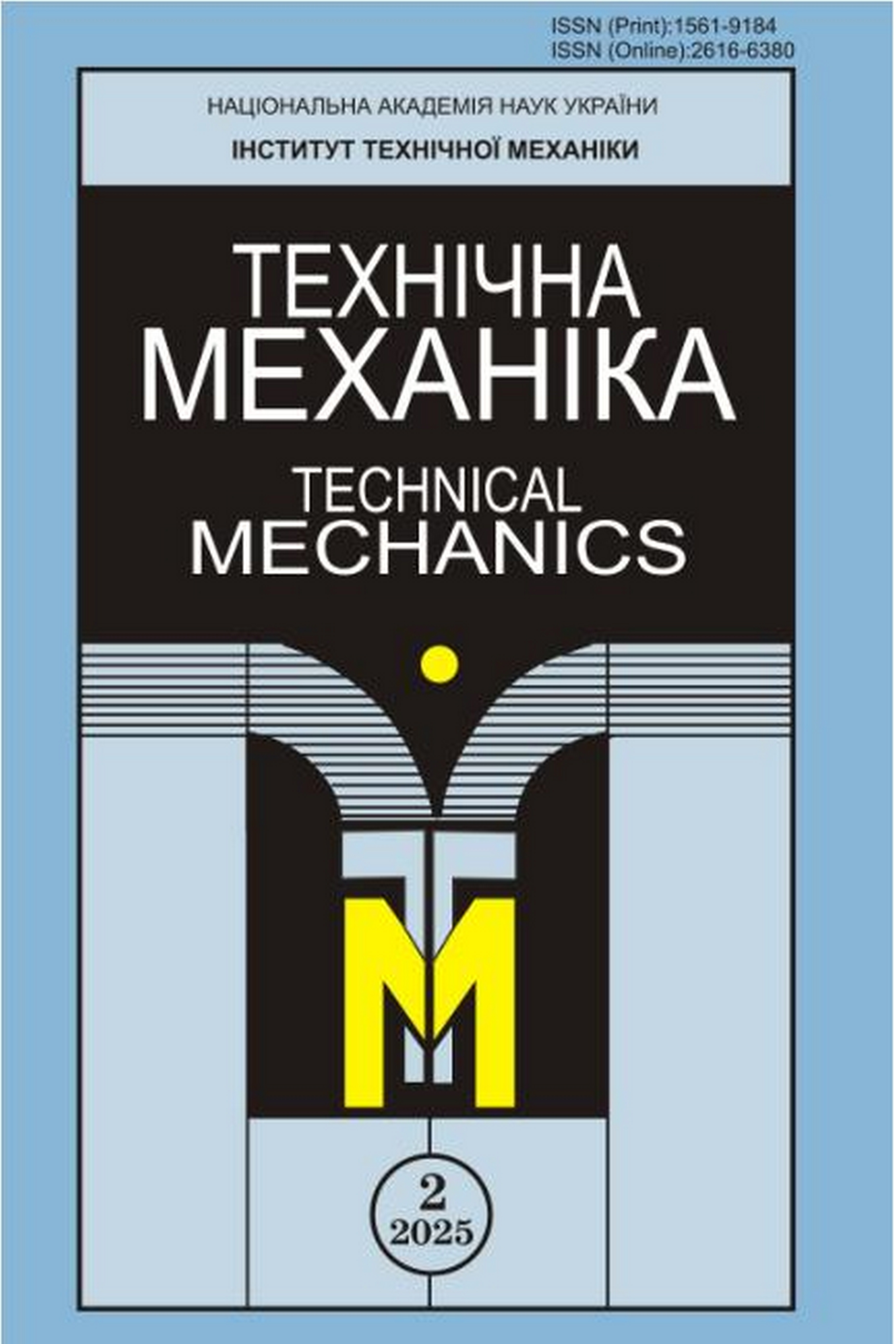MATHEMATICAL MODEL OF “GREEN”-PROPELLANT JET THRUSTERS AND ITS VERIFICATION
Keywords:
jet thruster, “green” monopropellant, mathematical model, verification.Abstract
DOI: https://doi.org/10.15407/itm2025.02.017
Spacecraft’s liquid-propellant jet thrusters serve as spacecraft control system actuators. Their main propellant is hydrazine, which is very toxic and difficult to use. Because of this, in recent years the world’s leading countries have paid much attention to a search for and the use of new untoxic “green” propellants, one of which is a water solution of three components: an ion substance, a fuel, and a stabilizer. A catalyst is installed at the thruster reaction chamber inlet for decomposing the ion substance to give an oxidizer, in whose presence the fuel burns to give high-temperature gaseous products, whose outflow through a supersonic nozzle produces a thrust. The development of thrusters of this type calls for a detailed study of thermochemical and gas-dynamic transformations in the thruster reaction chambers and hydraulic processes in the feed systems. Some of the reported developments of 0.1 N to 220 N “green” propellant thrusters were successfully tested in flight conditions.
Ukrainian developers of jet thrusters pay much attention to the use of LMP-103S “green” monopropellant for spacecraft of various purposes. Under development is a propulsion system with several tens of thrusters that differ in thrust scale and operating conditions and are fed from a common propellant tank. Its designing calls for the mathematical simulation of its operation.
The goal of this work is to adapt a comprehensive mathematical model of a system of liquid-propellant jet thrusters to LMP-103S monopropellant and verify it using data of single-thruster firing tests in ground and orbital conditions. The paper presents the basics of the adapted mathematical model, which describes an unsteady propellant flow in the pipelines from the tank to the thrusters, thermogas-dynamic processes in the reaction chambers, and the operation of electrically driven propellant valves for each of the thrusters. The model was verified for 1 N, 5 N, and 22 N trusters for different inlet propellant pressures characteristic of flight conditions. The calculated results showed that for a system of thrusters differing in thrust scale, their hydraulic coupling via the propellant feed system may result in their significant interplay, especially for thrusters differing in operating conditions.
REFERENCES
1. Anflo K., Gronland T. A., Bergman G., Nedar R., Thormahlen P. Development testing of 1- Newton AND-based rocket engines. 2nd International Conference on Green Propellants for Spaсe Propulsion, 7-8 June 2004, Chia Laguna (Cagliari), Sardinia, Italy, 11 pp.
2. Negri M., Grund L. Replacement of hydrazine: Overview and first results of the H 2020 Project Rheform. 6th European Conference for Aeronautics and Space Sciences (EUCASS), Krakow, PL. 2015, 12 pp.
3. Gohardani A. S.,Stanojev J., Demaire A., Anflo K., Persson M., Wingbord N., Nilsson C. Green space propulsion: Opportunities and prospects. Progress in Aerospace Sciences. 2014. V. 71. Pp. 128-149.
https://doi.org/10.1016/j.paerosci.2014.08.001
4. Persson M., Anflo K., Dinardi A., Bahu J.-M. A family of thrusters for AND-based monopropellant LMP-103S. 48th AIAA/ASME/SAE/ASEE Joint Propulsion Conference & Exhibit, Atlanta, Georgia, 2012.
https://doi.org/10.2514/6.2012-3815
5. Timoshenko V. I., Patryliak L. K., Knyshenko Yu. V., Durachenko V. M., Dolinkevych A. S. Use of a "green" propellant in low-thrust control jet engine systems. Teh Meh. 2021. No. 4. Pp. 29-43. (In Ukrainian).
https://doi.org/10.15407/itm2021.04.029
6. Rocket Engines - ECAPS. URL: https://www.ecaps.se (Last accessed on April 20, 2024).
7. Timoshenko V. I., Knyshenko Yu. V., Koshkin M. I. Computational and experimental support of the development of low-thrust jet propulsion systems. Teh. Meh. 2005. No. 2. Pp. 50-64. (In Russian).
8. Timoshenko V. I., Knyshenko Yu. V., Durachenko V. M., Anishchenko V. M., Korelsky A. V. Problems of development of controlling liquid jet system, which is powered from lines of a booster of the launch vehicle upper stage. Kosm Nauka Tehnol. 2016. V. 22. No. 1. Pp. 20-35. (in Russian).
https://doi.org/10.15407/knit2016.01.020
9. Timoshenko V. I., Knyshenko Yu. V. Influence of the gas saturation of a liquid on the peculiarities of unsteady flows in intricate pipelines. Journal of Engineering Physics and Thermophysics. 2018. V. 91. No. 6. Pp. 1434-1443.
https://doi.org/10.1007/s10891-018-1878-9
10. Knyshenko Yu. V. Dynamics of electrically controlled propellant valves for "green"-propellant thrusters. Teh. Meh. 2024. No. 3. Pp. 50-68. (In Ukrainian).
https://doi.org/10.15407/itm2024.03.049
11. ASTRA 4 / rs Software Package. Version 1:07S. Simulation of Chemical and Phase Equilibria at High Temperatures: User's Manual. Moscow: Bauman Moscow State Technical University, 1991. 38 pp. (In Russian).
12. Belyaev N. M., Belik N. P., Uvarov E. I. Spacecraft Jet Control Systems. Moscow: Mashinostroyeniye, 1979. 232 pp. (In Russian).
13. Anflo K., Thormahlen P., Persson M. Hot-firing tests using a low temperature derivative of LMP-103S. 5th European Conference for Aeronautics and Space Sciences (EUCASS), Munish, Germany, 2013. 9 pp.
14.Lyamaev B. F., Nebolsin G. P., Nelyubov V. A. Steady and Transient Processes in Complex Hydrosystems. Computer Calculation Methods. Leningrad: Mashinostroyeniye, 1978. 192 pp. (In Russian).
15. Decker M. M., Klein N., Freedman E. et al. HAN-Based Liquid Gun Propellants: Physical Properties. BRL-TR-2864, 1987. 64 pp.
16. Knyshenko Yu. V., Durachenko V. M. Mathematical model of the operation of a different-scale two-component low-thrust jet engine system. Teh. Meh. 2022. No. 3. Pp. 42-67. (In Ukrainian).
https://doi.org/10.15407/itm2022.03.047
17. Сhe J., Li G., Zhang T., Liu Y., Yang R., Chen Y. Catalac slenderness ratio and AND/methanol ratio for decomposition and combustion characteristics within ammonium dinitramide (AND)-based aerospace thruster. Chinese Journal of Chemical Engineering. 2019. V. 27. Pp. 1159 1165.
https://doi.org/10.1016/j.cjche.2019.01.017
18. Yoon W., Bhosale V. K., Yoon H. Reactor structure for the decomposition of ADN-based monopropellant. Aerospace. 2023 V. 10. 686.
https://doi.org/10.3390/aerospace10080686
19. Yoon W., Bhosale V. K., Yoon H. Reactor performance evaluation of ammonium dinitramide-based monopropellant in a 1 N thruster. Aerospace. 2024. V. 11. 110.
https://doi.org/10.3390/aerospace11020110






